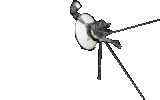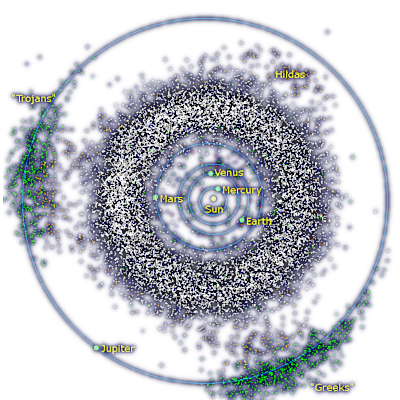
1.
Our Sun2.
Mercury Venus Our Moon Mars3.
Asteroid Belt
4.
Jupiter Saturn Uranus Neptune5.
Pluto6.
Comets
The asteroid belt is a torus-shaped region in the Solar System, located roughly between the orbits of the planets Jupiter and Mars, that is occupied by a great many solid, irregularly shaped bodies. These are called asteroids or minor planets, are of many sizes but much smaller than planets.
This asteroid belt is also called the main asteroid belt or main belt to distinguish it from other asteroid populations in the Solar System such as near-Earth asteroids and trojan asteroids.
About half the mass of the belt is contained in the four largest asteroids: Ceres, Vesta, Pallas, and Hygiea. The total mass of the asteroid belt is approximately 4% that of the Moon
Ceres is the only object in the asteroid belt large enough to be called a dwarf planet. It is about 950 km in diameter, whereas Vesta, Pallas, and Hygiea have mean diameters of less than 600 km. The other bodies range down to the size of a dust particle.
Individual asteroids within the belt are categorized by their spectra, with most falling into three basic groups: carbonaceous (C-type), silicate (S-type), and metal-rich (M-type).
The asteroid material is so thinly distributed that numerous unmanned spacecraft have traversed it without incident.
The asteroid belt formed from the primordial solar nebula as a group of planetesimals, the smaller precursors of the protoplanets.
Between Mars and Jupiter, however, gravitational perturbations from Jupiter gave the protoplanets too much orbital energy for them to accrete into a planet. Collisions became too violent, and instead of fusing together, the planetesimals and most of the protoplanets shattered.
As a result, 99.9% of the asteroid belt's original mass was lost in the first 100 million years of the Solar System's history. Some fragments eventually found their way into the inner Solar System, leading to meteorite impacts with the inner planets.
Classes of small Solar System bodies in other regions are the near-Earth objects, the centaurs, the Kuiper belt objects, the scattered disc objects, the sednoids, and the Oort cloud objects.
Reference: Wikipedia - Asteroid belt
A spacecraft mission
to explore our Solar System starts with its launch from earth using a rocket launcher. The spacecraft then uses its own engines to reach its objective and carry out its mission. Some missions have multiple objectives.
The duration of a mission varies, depending on the craft used and purpose of the mission.
The table below is an overview or all the successful spacecraft missions, to date, used to study asteroid belt objects. It only includes spacecraft that left Earth orbit to perform their mission.
Point to ℹ for table information. (Table head remains visible while scrolling)
Select the Spacecraft name or Target for more information.
| Img | Spacecraft | Launcher | Country | Year | Target | Notes | |
| Launch | End | ||||||
| 1 | Galileo | Space Shuttle STS-34 / IUS | U.S. | 1989 | 2003 | 951 Gaspra, 243 Ida |
Destined for Jupiter, flew past 951 Gaspra which is an S-type asteroid that orbits very close to the inner edge of the asteroid belt. Also flew past 243 Ida, an S-type asteroid in the Koronis family of the asteroid belt. |
| 2 | NEAR Shoemaker | Delta II 7925-8 | U.S. | 1996 | 2001 | 253 Mathilde, 433 Eros |
Near Earth Asteroid Rendezvous - Shoemaker (NEAR Shoemaker) flew within 1200 km of 253 Mathilde en route to 433 Eros. It flew past Eros in 1998 and then orbited it in 2000 and photographed its surface. In 2001 it landed on Eros' surface. This was the first time a Near Earth asteroid was closely visited by a spacecraft. |
| 3 | Deep Space 1 | Delta II 7326 | U.S. | 1998 | 2001 | 9969 Braille 19P Borrelly |
NASA technology demonstration spacecraft part of the New Millennium Program. Carried out a flyby of asteroid 9969 Braille and extended twice to include an encounter with comet 19P/Borrelly. |
| 4 | Stardust | Delta II 7426-9 | U.S. | 1999 | 2011 | 5535 Annefrank 81P Wild 2 |
Flew by and studied the asteroid 5535 Annefrank en route to its primary mission to collect dust samples from the coma of comet 81P Wild 2. |
| 5 | Hayabusa | M-V | Japan | 2003 | 2010 | 25143 Itokawa | Formerly known as MUSES-C, studied the asteroid in 2005 then landed on it and collected samples. These were returned to Earth aboard the spacecraft in 2010. Also carried a detachable minilander which failed. |
| 6 | Rosetta | Ariane 5G, V-158 |
Europe | 2004 | 2016 | 2867 Šteins, 21 Lutetia, 67P Churyumov - Gerasimenko |
Part of ESA's Horizon 2000 programme. Flew past asteroids 2867 Šteins and 21 Lutetia on its way to orbit comet 67P/Churyumov-Gerasimenko. Rosetta's lander, Philae, landed on the comet's surface to become the first spacecraft to land on a comet nucleus. Philae did not land as planned and its mission was cut short before all experiments were completed. Rosetta ended its mission by crashing into the comet. |
| 7 | New Horizons | Atlas V (551) Star 48B 3rd stage |
U.S. | 2006 | 2019 | 132524 APL, 486958 Arrokoth |
Part of NASA's New Frontiers program. Its primary mission to perform a flyby study of the Pluto system in 2015, and a secondary mission to fly by and study one or more other Kuiper belt objects. It is the fifth space probe to achieve the escape velocity needed to leave the Solar System. |
| 8 | Dawn | Delta II 7925H | U.S. | 2007 | 2018 | 4 Vesta, 1 Ceres |
Studied two of the three known dwarf planets of the asteroid belt, Vesta and Ceres. First spacecraft to orbit two extraterrestrial bodies,the first spacecraft to visit Vesta and Ceres, and the first to orbit a dwarf planet. |
| 9 | Chang'e 2 | Long March 3C | China | 2010 | 2014 | 4179 Toutatis | Luna observation from orbit for 6 months. Left orbit to flyby asteroid 4179 Toutatis. |
| 10 | Hayabusa2 | H-IIA 202 | Japan | 2014 | 2031 | 162173 Ryugu, 98943 Torifune, 1998 KY26 |
Carried multiple science payloads for remote sensing, sampling, and four small rovers that investigated the asteroid surface and collected samples. It left the asteroid in 2019 and is expected to return to Earth in 2020. Mission extended to flyby 98943 Torifune in 2026 and encounter 1998 KY26 in 2031. |
| 11 | OSIRIS-REx, OSIRIS-APEX |
Atlas V (411), AV-067 |
U.S. | 2016 | 2023 | 101955 Bennu, 99942 Apophis | Origins, Spectral Interpretation, Resource Identification, Security, Regolith Explorer is to obtain a sample from 101955 Bennu. It is currently in orbit around Bennu and is expected to return with its sample to Earth in 2023. Mission extended to flyby 99942 Apophis, a near Earth asteroid. |
| 12 | DART (LICIACube) |
Falcon 9 Blk 5 | U.S. | 2021 | 2022 | Dimorphos, 65803 Didymos |
NASA mission to test planetary defense against near-Earth objects (NEOs). In 2022 will deliberately crash into moon Dimorphos of double asteroid Didymos to assess impact to deflect an asteroid on a collision course with Earth. A small CubeSat, Italian LICIACube, sent with DART will separate and observe impact. |
| 13 | Lucy | Atlas V (401), AV-096 |
U.S. | 2021 | 2033 | 52246 - Donaldjohanson, 3548 Eurybates, 15094 Polymele, 11351 Leucus, 21900 Orus, 617 Patroclus |
NASA's Discovery Program missions 14. A probe on a 12 year mission to 8 asteroids, 1 main belt and 7 Jupiter trojans including 2 binary asteroids. It will gain two gravity assists from Earth; one in 2022, and one in 2024. In 2025, it will fly by the inner main-belt asteroid 52246 Donaldjohanson. In 2027, it will arrive at the L4 Trojan cloud of asteroids that orbits 60° ahead of Jupiter, where it will fly by 3548 Eurybates (and satellite Queta), 15094 Polymele, 11351 Leucus, and 21900 Orus.Another Earth gravity assist in 2031 will send Lucy to the L5 Trojan cloud which trails 60° behind Jupiter, where it will visit the binary Trojan 617 Patroclus (and binary asteroid Menoetius) in 2033. Lucy will then be in a 6-year orbit between the L4 and L5 clouds, and a mission extension will be possible. |
| 14 | Psyche | Falcon Heavy | U.S. | 2023 | 2031 | 16 Psyche | Explore the origin of planetary cores by orbiting and studying the metallic asteroid 16 Psyche. |
| 15 | Hera | Falcon 9 Blk 5 | U.S. | 2024 | 2026 | 65803 Didymos | Study the Didymos binary asteroid system that was impacted by the NASA Double Asteroid Redirection Test (DART) spacecraft and contribute to validation of the kinetic impact method to deviate a near-Earth asteroid. |
| 16 | Tianwen-2 | Long March 3B | China | 2025 | 2035 | 469219 Kamoʻoalewa 311P PanSTARRS |
Sample return from asteroid 469219 Kamoʻoalewa in 2027, rendezvous with main-belt comet 311P PANSTARRS in 2035. |
This gallery contains images of spacecraft and their launch vehicles (rockets) used on the above missions. (Numbers relate to the table above)
Thumbnails: Click on a thumbnail image to enlarge it. | Enlarged image: Click on right side of image for next image or on left side for previous image. Click outside image to close.